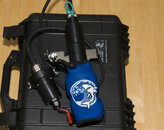I don't treat my light with kid gloves, but I don't abuse it. I figure if they're designed to hold up to the rigors of cave/tech diving, ("exploration-grade") then they should be fairly robust.
That said, I do rinse it after each dive, especially in salt water. When I travel in the car, my kit is usually fully assembled, so the light just rides on the belt and the light-head clipped to the harness, resting on top of the rig. If it's not, I just put the light in my dive bag, with the light head on the top and nothing on top of it. I took a trip to Fiji in June and I just had it in my carry-on with the light head wrapped in a couple of t-shirts. Made the trip there and back with no problems.
I do keep hearing about the HID bulb being fragile, and mine has held up to a lot of use. I am in the water with it at least 3-7 times a week and it's still going strong after a year of use, travel and what-have you. I need to get a spare, but I haven't yet.
I do store it with the battery fully charged, since I have let it run down a few times, and apparently NiMH has a problem with self-discharge and polarity reversal after a certain voltage threshhold, and I've screwed it up, destroying my burn time, (I'm getting 2 hours or less now, and it should be 4 hours). My bad. I learned on that one. Likely a damaged cell or two.
I have a Halcyon 9/21w and I just sent it in to them for their "annual service". It's $50, and they replace all the o-rings and seals, inspect the bulb, run a burn test on the light and give you a graphical print out of the voltage over time, and pressure-test it. For another $30, they will replace the light cord. I spoke to their head of tech services and he said that he might be able to bring my battery back, and restore some burn time. Might be a waste of money, but I wanted to send it to them anyway because of the battery, and I figured why not go through it if it's there?





